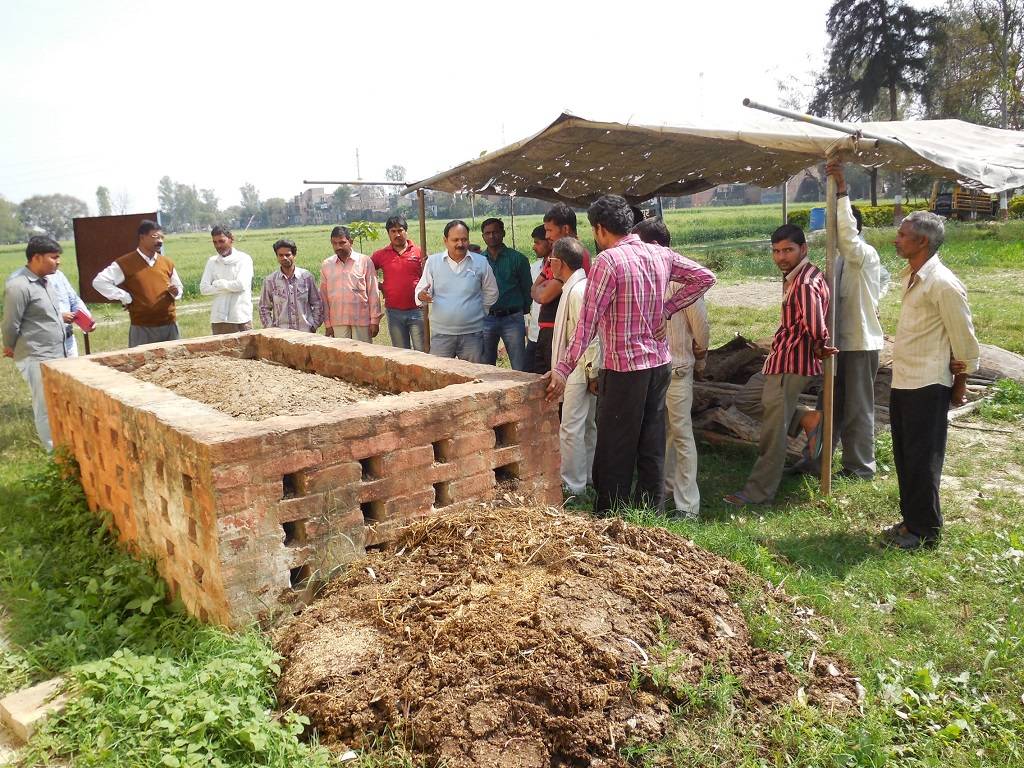
The NADEP method of making compost was first invented by a farmer named Narayan Deotao Pandharipande. This method is quite popular among farmers in dryland conditions, where organic manures play a big role by not only supplying balanced nutrients but also retaining substantial amount of moisture.
Traditionally, farmers used to apply farmyard manure to crops grown under rainfed conditions and usually prepared through the pit method. No scientific measures are followed for preparing the manure and as a result, the quality of the manure used to be very poor. Compost making is an efficient way of converting all kinds of biomass into high-value fertilizer that serves as a good alternative to farmyard manure, especially for crop-growing households without livestock.
Farmers selected the Site for NADEP Tank. They permanently built tanks of clay bricks in the cement size 6 X 4 X 3 feet. This, NADEP tank was filled in one or two days with the dry and green plant farm residue materials, Cow dung, or partly dried bio-slurry by spraying water and kept as it for 90-120 days.
Qualities of Compost
Although the quality of compost is best evaluated through the growth and productivity of the plants grown on soil treated with it, it is possible to evaluate compost quality through seeing, touching, and smelling:
-
Good quality compost is rich in plant nutrients and has a crumb-like structure, like broken-up bread.
-
It is either black or a dark brown color, and it retains moisture efficiently; as a result, it does not dry out quickly.
-
It smells lovely, like freshly ploughed, clean dirt.
Benefits
-
Prepares compost in less duration of 90-120 days in which traditional pit method requires 1-2 years.
-
Reduced cash expenses on chemical fertilizer, improved soil fertility, increased yield
-
Supports organic crop production, reduced dependence on outside inputs
-
From each NADEP tank approximately 1 ton of compost is prepared within 90-120 days.
-
The use of compost reduced the need for mineral fertilizer thus reducing production costs and outside dependence.
-
Also, waste decomposer bottles were distributed in 25 villages along with the information regarding its use for rapid composting.
Raw materials mandatory for filling NADEP tank
-
Agricultural waste (Dry & green) – 1350-1400 kgs.
-
Cattle dung or biogas slurry – 98 – 100 kgs.
-
Fine soil – 1675 kgs.
-
Water – 1350-1400 L
The key step in making Nadep compost is to fill the tank completely all at once, within 24 hours, and no later than 48 hours to avoid affecting the compost's quality. Thatched roof, Brick Wall Flooring, Air Vents, Green-farm technologies for small and marginal farms Resources Center for Sustainable Development
Before filling: The tank is plastered with dilute cattle dung slurry to facilitate bacterial activity from all four sides. It is also filled in definite layers each layer consisting of the following sub layers.
Sub-layer-1
To facilitate aeration need a 4 to 6 inch-thick layer of fine sticks, and stems, followed by 4 to 6 inch layer of dry and green biomass.
Sub-layer-2
To encourage microbial activity, 100 litres of water and 4kg of cow dung are combined and liberally sprinkled over the agricultural waste.
Sub-layer-3
A consistent layer of 60 kg of fine, dry soil is applied to the soaked biomass to help retain moisture and acts as a buffer during biodegradation. Therefore, 100 kg of organic components makes up each layer.
Biomass: 4 kg of cow dung, 100 l of water, and 60 kg of soil. Each tank is filled with around 10 to 12 layers using this method. Following tank filling, the biomass is covered with cow dung + mud plaster and topped with a 3-inch-thick layer of soil.
Management
-
The organic material in the tank is automatically pressed down to 2 feet after 15–30 days of filling.
-
The tank is refilled by giving 2-3 layers over it and is resealed.
-
After this filling, the tank is left alone for three months except that it is moistened at intervals of every six to fifteen days.
-
The entire tank is covered with a thatched roof to prevent excessive evaporation of moisture.
-
There should never be any space for cracks to appear. If they do, slurry should be added to them right away.











